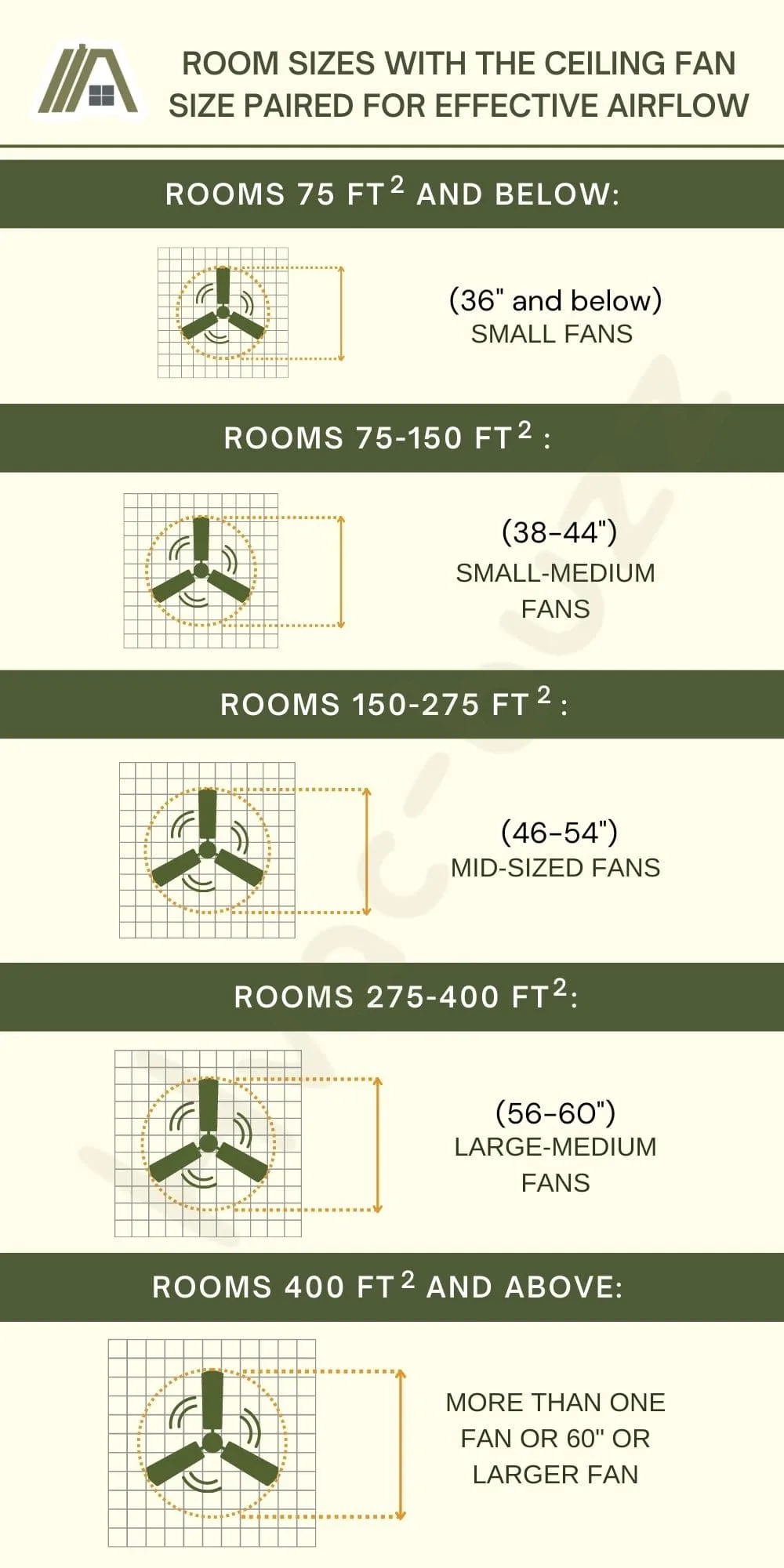The wattage of the fan you buy affects how much electricity it will use and if it will circulate air well in a given room.
Knowing the average ceiling fan wattage, you can verify if the model you’re interested in is on-par with most other models of that size. If you can’t find the wattage for your model, here, you’ll learn to calculate it so you can reach air circulation and energy goals.

- 36″ = 38.13 W
- 42″ = 43.32 W
- 44″ = 52.33 W
- 48″ = 54.03 W
- 52″ = 50.64 W
- 54″ = 61.92 W
- 60″ = 45.72 W
Table of Average Ceiling Fan Wattages
Information from six different popular ceiling fan brands (listed below) was used to calculate the average wattage for each model (particular size of blade sweep).
Fan models were chosen based on which sizes were most frequently bought. Medium-sized fans (44-58″) are most prevalent, with 52 inches (amazon link) being the go-to. Meanwhile, smaller (42″ and below (amazon link)) and larger (60″ and above (amazon link)) fans are less commonly used.
Original data came from the following popular brands:
- Minka Aire
- Monte Carlo
- Hunter
- Harbor Breeze
- Honeywell
- Hampton Bay
Any size a brand didn’t sell was removed from calculating averages. If the information for multiple speeds of the fan was provided, the information for the high-speed setting was used.
| Fan Size | Average Wattage | Average Amp Draw | Average CFM |
| 36″ | 38.13 | 0.345 | 2958 |
| 42″ | 43.32 | 0.362 | 3007.64 |
| 44″ | 52.33 | 0.436 | 3365.67 |
| 48″ | 54.03 | 0.451 | 3958.33 |
| 52″ | 50.64 | 0.423 | 3619.5 |
| 54″ | 61.92 | 0.517 | 5800.4 |
| 60″ | 45.72 | 0.382 | 5682 |
Calculating Wattage
Perhaps you would like to compare your fan’s wattage to the average wattage for its size. If you can’t find the wattage on the packaging, motor, or in the online manual, you can calculate it using amps and voltage.
If wattage isn’t reported, the amp draw should be. It’s often in the user manual, on the fan’s packaging, on the actual fan itself, or in the online manual (which can be found on the manufacturer’s website).

Once you find the amps, you’ll be able to calculate the fan’s wattage using the standard voltage of outlets (unless a voltage is given where the amp information was found). In the US, this is the supply voltage of 120 volts.
Finally, you can use the equation which connects Watts, Amps, and Volts:
Watts = Amps x Volts
Plug in the two values you know to get the third. In this case, multiply 120 V by the amps for your specific fan model to get the wattage.
Is Average Ceiling Fan Wattage Energy Efficient?
Energy star specifications for ceiling fans look at minimum efficiency, which is calculated as CFM divided by watts. This CFM/watt for the high-speed setting must be equal to or greater than 75.
Using the above table and dividing the average CFM by the average wattage for each model, the fan sizes 36, 54, and 60 inches meet this standard while the others fall slightly short (range of ~64 to ~73 CFM/watt).
Benefits of Knowing Average Amp Draw
Why do we need to know the average amp draw? First, as explained previously you can calculate wattage if you know the amp draw and voltage (which is mostly assumed to be 120).
Second, wattage and amps have a positive relationship; that is, when one increases the other also increases. The amp draw and wattage give an indication of the amount of electric current the appliance can handle and how much power the appliance will use.
This is important to know for determining what circuits the fan can be put on (i.e., the compatibility with the electricity system in your house), how much energy your fan will consume, and how powerful it will be.
Choosing the Correct Fan Size For You
One impulse you may have is to buy a fan size based on price. Because higher wattage usually translates to a higher cost, you might consider buying the fan with the lowest wattage. However, this isn’t a good strategy for having the correct fan in a given room.
Fan sizes affect the CFM—the function of the ceiling fan to move air in cubic feet per minute. The fan size, or “blade sweep”, isn’t an aesthetic choice; it’s important to the purpose of the fan (airflow), which is why we included the average CFM in the table.

The ceiling fan size you need will be based on the size of the room where you’re installing it. Here is a list of room sizes with the ceiling fan size paired for effective airflow:
- Rooms 75 ft2 and below: small fans (36″ and below)
- Rooms 75-150 ft2: small-medium fans (38-44″)
- Rooms 150-275 ft2: mid-sized fans (46-54″)
- Rooms 275-400 ft2: large-medium fans(56-60″)
- Rooms 400 ft2 and above: more than one fan or 60″ or larger fan
If your room size is close to the edge of a range (or you would like more airflow), you can get a larger size than listed here.
Sources
https://www.energystar.gov/products/lighting_fans/ceiling_fans/ceiling_fans_key_product_criteria
https://www.energystar.gov/sites/default/files/specs/private/Ceiling_Fans_V3_Specification.pdf
https://www.minkagroup.net/indoor/
https://www.montecarlofans.com/Indoor-Ceiling-Fans.htm
https://www.hunterfan.com/collections/ceiling-fans
https://www.honeywellstore.com/store/products.asp?friendly_url=honeywell-ceiling-fans

